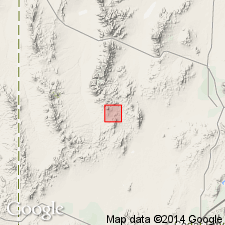
- Usage in publication:
-
- Blawn Formation*
- Modifications:
-
- Named
- Dominant lithology:
-
- Tuff
- Rhyolite
- AAPG geologic province:
-
- Great Basin province
Summary:
Named for Blawn Wash, southern Wah Wah Mountains, Beaver Co, UT in Great Basin province. Type section is at intersecting corners of Lamerdorf Peak, Frisco, The Tetons, and Blue Mountain quads, at 38 deg 15 min N and 113 deg 30 min W, sec 35, T29S, R15W. Well exposed along southeast flank of Wah Wah Mountains. Is a bimodal assemblage of silicic intrusive and extrusive rocks, and potassium-rich mafic lava flows emplaced between 23 and 18 m.y. ago. Has radiogenic 40[superscript]Ar 18.0 +/-0.5 to 23.2 +/-1.0 ages. Includes stratified volcanic sand and pumice, crudely stratified air-fall tuff, and weakly welded, crystal-poor ash-flow tuff at base. Basal sequence followed by 1) porphyritic trachyandesite lava flows, and 2) loosely consolidated rhyolitic tuffs, air-fall ash and pumice, and reworked water-laid tuffaceous sand. Is about 600 m thick at type. Overlies Isom Formation; underlies mid-Miocene mafic lava flows of Steamboat Mountain Formation (adopted). Intertongues with Condor Canyon Formation. Of early Miocene age. Stratigraphic chart.
Source: GNU records (USGS DDS-6; Denver GNULEX).
For more information, please contact Nancy Stamm, Geologic Names Committee Secretary.
Asterisk (*) indicates published by U.S. Geological Survey authors.
"No current usage" (†) implies that a name has been abandoned or has fallen into disuse. Former usage and, if known, replacement name given in parentheses ( ).
Slash (/) indicates name conflicts with nomenclatural guidelines (CSN, 1933; ACSN, 1961, 1970; NACSN, 1983, 2005, 2021). May be explained within brackets ([ ]).

